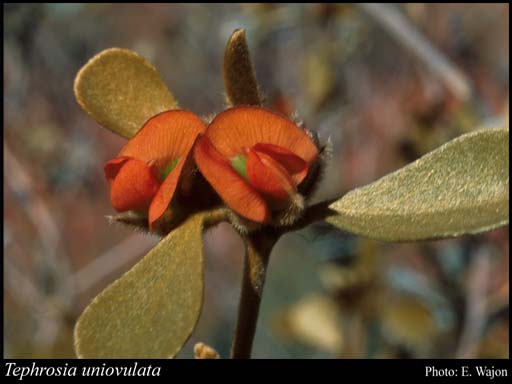- Reference
- Fragm. 11:70-71 (1879)
- Conservation Code
- Not threatened
- Naturalised Status
- Native to Western Australia
- Name Status
- Current
Shrub, 0.1-1.3 m high, 0.25-1.8 m wide. Fl. orange, Apr to Oct. Red sandy & loamy soils, often with pebbles. Low rocky ridges, sand plains & dunes.

Scientific Description
Erect, shrub, spindly shrub (broom-like). Stems terete, not spiny, hairy; pustules or glands absent. Leaves or phylloclades clearly present, simple, alternate, continuous with stem, 15-40 mm long, 6-17 mm wide, hairy, with simple hairs, flat with flat margins; margins entire; tubercles absent; pustules or glands absent. Stipules present and persistent to older leaves. Bracteoles present and persistent. Calyx 6-7.5 mm long, not accrescent, hairy, with simple hairs, ribless; pustules or glands absent. Corolla uniformly coloured, orange; claws present; standard 7.2-8 mm long, hairy at least in part, not auriculate, wings 7.5-8.5 mm long, not auriculate, keel 7.5-8 mm long, not beaked, not auriculate, glabrous. Stamens ten; anthers 0.4-0.5 mm long, at two different levels (filaments alternately long and short); filaments united in an open sheath with one free stamen, 5-7 mm long. Ovary sessile or subsessile, hairy or glandular; style 8-9 mm long, hairy or glandular towards the base, not bearded, flattened at apex. Fruit dehiscent (a pod or follicle), sessile or subsessile, constricted between the seeds, round in cross-section, not beaked. Flowers in April, May, June, July, August, September and October. Occurs in the Eremaean Botanical Province, in the Pilbara, Carnarvon and Gascoyne IBRA regions.
Distribution
- IBRA Regions
- Carnarvon, Gascoyne, Pilbara.
- IBRA Subregions
- Ashburton, Cape Range, Chichester, Hamersley, Roebourne, Wooramel.
- Local Government Areas (LGAs)
- Ashburton, Carnarvon, Exmouth, Karratha.